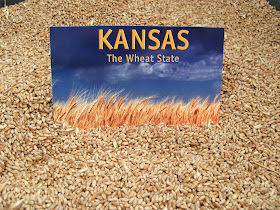A Time to Think
Some days there won't be a song in your heart.
Sing anyway.
–Emory Austin, motivational speaker
(From my email devotional from Guideposts)
The tires clickety-clacked over the small wooden bridge. I'd been over it three times already, and each time, I turned to the left as I passed. A creek meandered through a pasture, and clouds dotted a blue August sky. It registered each time, but I didn't stop the car. I thought I didn't have time to dig through my purse and unearth the camera when I had another place to be.Sing anyway.
–Emory Austin, motivational speaker
(From my email devotional from Guideposts)
But, on my final trip (for now), returning from Miller Seed Farm, I decided I'd stop. I looked both directions on the rutted dirt road and didn't see anyone coming. I wasn't going to block anyone's progress in a farm truck as it rambled to get seed wheat cleaned or force anyone to wiggle by me on the narrow road.
It was an uncharacteristically cool morning for August. As I stepped on the bridge and jockeyed around, trying to figure out the best angle, I heard the creek babbling under my feet as it made its way under the bridge, doing the Limbo under the fence and gurgling its way through the green grass-fringed banks. Birds sounded their own tune, and the grasses provided the gentle drum brush accompaniment. And I remembered the words of the devotional that I'd just read the day before:
Some days there won't be a song in your heart.
Sing anyway.
When I am distracted by my agenda or by my worries or by my disappointments or the latest farm breakdown, it's easy to forget to "sing." When I feel that way, it's easier to drive right by those everyday, ordinary gifts from God and hardly even notice the miracles right outside my window.
I was in my basement office, nowhere near the sky, when Randy called me from the tractor.
"It's a beautiful sunrise," my farmer told me.
So I left my computer and drove down the road. When I saw the sky, my first thought was of the hymn, "When morning gilds the skies, my heart awakening cries! Let Jesus Christ be praised!"
And then, when I was editing the photos later, a simple children's Sunday School song drifted in my mind: "Jesus wants me for a sunbeam, to shine for him each day. In every way try to please Him, at home, at school, at play. ... I'll be a sunbeam for Him."
When those dark clouds cover up my "sunbeam," I still need to remember to shine ... and sing.
 |
| Taken as I delivered Randy to the tractor to bale. By the time I had gotten him there, the sun had almost sunk below the horizon. |
12 For you shall go out in joy, and be led back in peace;
the mountains and the hills before you shall burst into song,
and all the trees of the field shall clap their hands.
Isaiah 55:12


























































